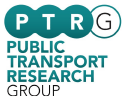Pareto-improving policies for an idealized two-zone city served by two congestible modes
Document Type
Journal Article
Publication Date
2017
Subject Area
place - urban, mode - car, mode - rail, policy - congestion, ridership - commuting, ridership - behaviour, ridership - mode choice, economics - subsidy, land use - urban sprawl, land use - impacts
Keywords
Monocentric city model, Dynamic congestion, Land use tax, Transit subsidy, Urban sprawl, Pareto improving
Abstract
We study urban structure and traffic congestion of a monocentric city by idealizing its suburb and its core as two zones and then exploring what would happen when they are connected by a congestible highway and a crowded railway system. We introduce dynamic congestion effect into commuters’ departure-time and mode choice behaviours, and analyse the endogenous interactions between their travel and residential relocation choices. Studies ignoring dynamic departure-time behaviour show an ambiguous effect of transit improvements to the city. However, we find that transit improvement has a definitive impact on city structure: it increases the residents’ equilibrium utility, at a cost of increased suburb land use. We show that it is possible to design Pareto-improving land-use and transit policies which benefit the residents without causing urban sprawl. We provide analytically the existence conditions of such policies and suggest that a high return of land use tax to subsidize transit improvement is required.
Rights
Permission to publish the abstract has been given by Elsevier, copyright remains with them.
Recommended Citation
Xu, S.-X., Liu, R., Liu, T.-L., & Huang, H.-J. (2017). Pareto-improving policies for an idealized two-zone city served by two congestible modes. Transportation Research Part B: Methodological, Available online 24 August 2017. In Press, Corrected Proof.



Comments
Transportation Research Part B Home Page:
http://www.sciencedirect.com/science/journal/01912615